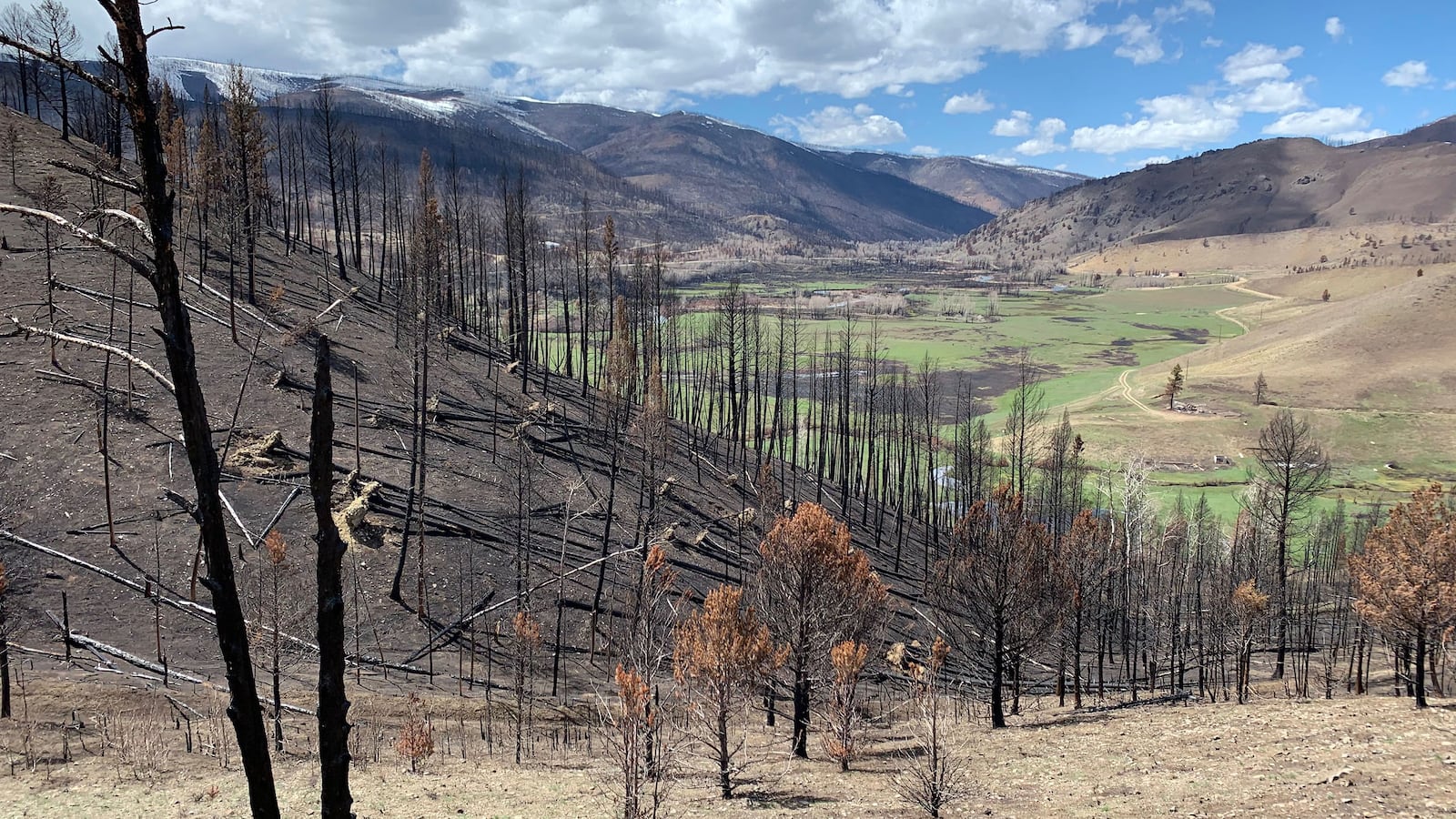It’s a calm, early August day when I drive up the rutted dirt road that leads to C Lazy U Ranch. The 102-year-old luxury guest ranch is the last stop on a 10-day road trip around western Colorado. My husband and I slow to a stop in front of the reddish-brown barn. Some of the ranch’s 200 horses are nibbling bites of hay and grass from rows of troughs. Guests amble by, their cowboy boots kicking up tiny swirls of dust. The sky is perfectly clear, still shocking me with the intensity of its blueness even though I’ve lived in the state for more than a decade.
Less than three months later, that same horizon would turn charcoal and the peaceful scene before us would be flattened. The East Troublesome Fire spread onto the ranch in late October, forcing guests back to their homes and staff to evacuate themselves and the livestock. The wildfire eventually burned nearly 194,000 total acres in northern Colorado, becoming the second largest in state history. In its wake, C Lazy U’s barn, originally built in 1922, was reduced to bits of wood and metal, orange embers glistening amid the rubble. Seven hundred tons of hay ignited and burned for five days. A guest cabin, two employee housing structures, and eight ranch member homes were also destroyed. The ranch shuttered for five months and calculated its losses in the tens of millions.
Wildfires are commonplace in the West, but 2020 was a particularly bad year for them. Three of Colorado’s largest-ever wildfires ignited in the summer and fall. In California, more than four million acres burned and 33 people died. Oregon saw an increase in fires starting in or near towns, resulting in the loss of more than 4,000 homes; in 2019, just two were destroyed by wildfires. Venues all over the West, such as Calistoga Ranch, a luxury resort, and Simple Machine Winery and Tasting Room, were razed. National parks and other public lands were forced to close due to unsafe air quality that turned the air a dystopian orange hue.
Science tells us these occurrences are not a fluke, but rather our new normal. Wildfires are burning larger and longer, southwestern states are getting drier, and floods are more common. Many popular tourist destinations—for outdoor recreation, wine tasting, and other pursuits—are located in or near susceptible landscapes. Already this year, red flag warnings (indicators of increased fire danger) were announced in Oregon and Washington, and a 150-foot section of California’s iconic Highway 1 washed away in a mudslide. Facing an unpredictable future, the travel and tourism industry is being forced to adapt and consider how a changing climate may alter visitors’ itineraries.

“I don’t think we can plan on having a lot of people from around the country visiting us. I think we need to concentrate on what’s happening here locally and embrace that,” said Rene Byck, co-owner of Paradise Ridge Winery in Santa Rosa, California. The property was closed for two years after suffering extensive damages during the Tubbs Fire in 2017, including losing a hospitality center and 10,000 cases of wine. “We were not worried about fires before 2017,” Byck said. Now, smoke barrels over the property every year.
The winery reopened in December 2019. Buildings that formerly had wood decks were rebuilt with ceramic tile. Byck purchased a generator so he could keep the electricity running during widespread power shutoffs, which often occur during late summer, the winery’s busiest season. A fire hydrant allows the team to tap into well water on the property in an emergency, and staff are relying on livestock and more active mowing to keep grasses shorter.
Byck wants to encourage people to visit wine country in the spring when fires and power shutoffs are less likely (and—perk!— rates are cheaper). He concedes that vino vacations may begin to shift north to Oregon and Washington as the Russian River Valley grows hotter and drier.
“I have no idea what’s going to happen other than we’re trying our best to make lemonade,” Byck said.
Even areas not directly impacted by wildfires, like Paso Robles Wine Country along California’s Central Coast, can face closures due to smoke and poor air quality. Several of Hearst Ranch Winery’s vineyards experienced so much damage from smoke taint—from fires burning more than 200 miles away—that the grapes were ruined. “There’s not much one can do to protect your vineyards from smoke,” said owner Jim Saunders.
That’s an economic problem. But there are also secondary repercussions, such as employees losing their own properties to these disasters and being unable to return to work for extended periods.
Long-term impacts must be navigated, too. “There’s no game plan…You’re really having to play it by ear and make future decisions based on data that’s incomplete. It’s an incredibly difficult situation,” said Tony Warnock, president and CEO of Lost Valley Ranch in Sedalia, Colorado. Ninety-five percent of the property’s 36,000 acres of federally permitted land burned during the 2002 Hayman Fire (Colorado’s largest until 2020). Though Lost Valley’s deeded land was mostly spared, and no significant structures were impacted, spot fires, flooding, and other lingering issues “affected our operation for several years afterward,” Warnock said. When the property reopened to guests three months post-fire, “the scenery had changed, the topography was different,” he said. “Our riding program was reduced and limited. Our cattle operation was adversely affected for several years because it took quite a while for regrowth in this region. We lost a ton of revenue.”
Warnock isn’t worrying himself about another fire of Hayman’s magnitude—“I tell people we’ve had our fire,” he said—but he admits, “this is an ongoing problem for anybody that’s in the West… When we live and work out in this country, fires are part of the reality, and we need to be able to adapt and evaluate our business model based on that reality.”
That new world isn’t bringing all bad news. Elk and deer have since returned to the area surrounding Lost Valley, in higher numbers than ever before. Wildflowers are carpeting the ground. Warnock calls it an “interactive ecology”—one that’s not pristine, but in process. “There is an experience in that, too, that is valuable, and I really encourage people to engage in that and to not be afraid,” he said. “Don’t avoid [places like] C Lazy U because they had a fire recently. Go and experience what it’s like when the land is coming back together in the way it’s supposed to.”

Today, the guest experience remains relatively unchanged at C Lazy U, though traces of the fire still mark its 8,500 acres. Blackened soil sits within inches of cabin walls and decks. Dead trees still need to be cleared, and some pastures and trails remain inaccessible, though more routes will reopen throughout the summer. The barn’s dirt footprint awaits its next iteration, which is already in progress. Just like fire fuels regrowth, general manager David Craig views the East Troublesome Fire as an opportunity to ready the ranch for its next 100 years. “[C Lazy U] has been through famine, world wars, a plague. At some point, this fire is going to look like a blip on the radar,” Craig says.
In mid-May, I rode a white horse named Starbucks through the charred landscape on the north side of the property. The standing trees still appeared to be in shock—their empty, blackened branches all blown in one direction. Tree stumps had lost their tops, which disintegrated in the heat. Broken off, seared logs lay on the forest floor; they had a metallic sheen, like spray-painted alligator skin. Willow bushes and sage plants at ground level lost their ornaments, and their emaciated branches were sharpened into spears, a danger to horses should they step off-trail. In some spots, a faint smoky scent still hung in the air. Already, though, the land was regenerating. Grasses and small bouquets of wildflowers were peeking into the sunshine. Ground squirrels scurried across the trail. Green trees stood strong next to their singed neighbors. As birdsong floated over me, I thought of what Ami Cullen, director of equestrian operations, told me earlier that day: “This is all going to come back. I view the fire as being part of the mountains.” Spring was on the horizon.

